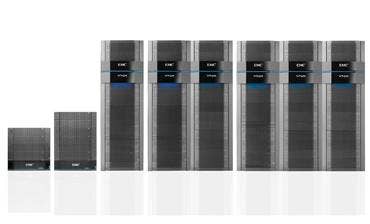EMC: Second-Generation VNX Brings Huge Speed, Capacity Leap

EMC Tuesday unveiled its second-generation VNX storage array featuring a new multicore architecture and a new operating system that can take advantage of that hardware.
EMC, using the Formula 1 racing event in Milan, Italy, as a backdrop, also said that its new EMC ViPR software-defined storage solution is expected to ship in September. It includes support for Object Data Services, which supports Amazon S3, OpenStack Swift and Atmos APIs while enabling enterprises and service providers to store, access and manipulate objects.
The second-generation VNX, which EMC claims can provide up to 1.1 million IOPS (I/Os per second) performance, 30-GBps bandwidth, and 6 PB of capacity, will be available as a stand-alone array and as part of four new configurations of the EMC VSPEX reference architecture for integrating server, storage and networking resources, said Eric Herzog, senior vice president for EMC's Unified Storage Division.
[Related: EMC's New Software-Defined Storage Play: Meet ViPR ]
Herzog said the second-generation VNX will be at the center of a new preconfigured Vblock converged infrastructure solution from VCE. VCE, a joint venture of EMC, Cisco and VMware, is expected to launch that and other new Vblocks later this month, Herzog said.
The second-generation VNX launch is very important for the channel, said Keith Norbie, director of server, virtualization and storage for the Eastern U.S. for Technology Integration Group (TIG), a San Diego-based solution provider and EMC partner.
"I think this will be real big," Norbie said. "EMC is introducing new models priced both above and below its existing VNX models. It's part of EMC's bifurcated strategy. They're letting customers go downscale, or above and beyond in terms of performance."
John Flisher, technical consultant manager at eGroup, a Mt. Pleasant, S.C.-based solution provider and EMC partner, said eGroup is preparing a huge road show to get information about the new VNX to customers in the same fashion the company did with the release of the original VNX.
NEXT: Channel-Led Launch Of The Second-Generation VNX
"This is huge for us," eGroup's Flisher said. "EMC goes all out with these releases. There will be a full-on marketing event, which doesn't just focus on the arrays. But we can expect something like when EMC crammed all those people in that small car during the original VNX launch."
Herzog said that the second-generation VNX launch is a channel-led one.
In addition to making the new VNX a part of EMC's VSPEX reference architecture and the center of a new VCE Vblock offering, both of which are channel-only solutions, EMC is also working with its four North American distributors -- Arrow, Avnet, Tech Data and Ingram Micro -- to hold simultaneous solution provider presentations around the country, he said.
Those programs include both distributor- and solution provider-provided content as well as footage from the main launch event held in Milan, Herzog said.
EMC also is creating launch and demand generation kits for the new VNX, including a series of "Webinar-in-a-can" and "seminar-in-a-can" presentations, demand generation campaigns, 40 post-launch EMC Forums bringing partners and customers together, and new VNX-based "Shark Week" promotions the company offers on a periodic basis, according to Herzog.
One thing that won't be heard from EMC is the term "VNX2." Unlike previous press reports calling the new offering "VNX2," the official name is the second-generation VNX, he said.
While solution providers said EMC has referred to the new solution as "VNX2" in the past, Herzog said the previous code name was "VNX Rockies."
EMC first unveiled the original midrange VNX and SMB VNXe arrays more than two years ago.
EMC has been hinting about the upcoming release of the new VNX, beginning in May at EMC World, and in July provided the most recent update during the EMC second fiscal quarter conference call.
The second-generation VNX offers a huge performance increase over the existing VNX due to EMC's new multicore processing, or MCx, technology to increase performance of the new solution to up to 1.1 million IOPs, or nearly five times the IOPs of the current VNX.
MCx features dynamic core utilization that levels the various tasks of the VNX, including RAID, I/O, cache, data services and management, across multiple processor codes rather than running each task in its own core to increase performance.
To take advantage of the MCx technology, EMC also is making a significant update to its VNX operating system, which until now has been a combination of EMC's legacy FLARE SAN operating system and DART NAS operating system, united behind a common GUI.
With its second-generation VNX, the new storage operating system takes advantage of the MCx technology by spreading the various tasks across multiple cores to increase overall core utilization.
The software also ensures better utilization of flash storage in the array. Herzog said the second-generation VNX arrays now feature 22 PCIe slots and 160 PCIe lanes compared with only 11 slots and 16 lanes in the original VNX.
"We make sure the hardware doesn't slow the flash down," he said. "We are using multithreading and multicores as a way to manage storage," he said. "In the past, the software was assigned to specific cores. Now it's spanned across the cores."
Herzog also said the software includes block-level duplication at no charge to help cut the amount of data customers actually store on the array. As a result, the new VNX in a two-node cluster offers considerably higher performance than competitive arrays featuring from two to 16 nodes, he said.
The second-generation VNX will be available in several models, as well as in flash storage-only configurations for high-performance applications.
EMC also is introducing a VNX-CA (Continuous Availability) solution that leverages the capabilities of EMC VPLEX's virtual storage technology to deliver continuous availability of data.
PUBLISHED SEPT. 4, 2013